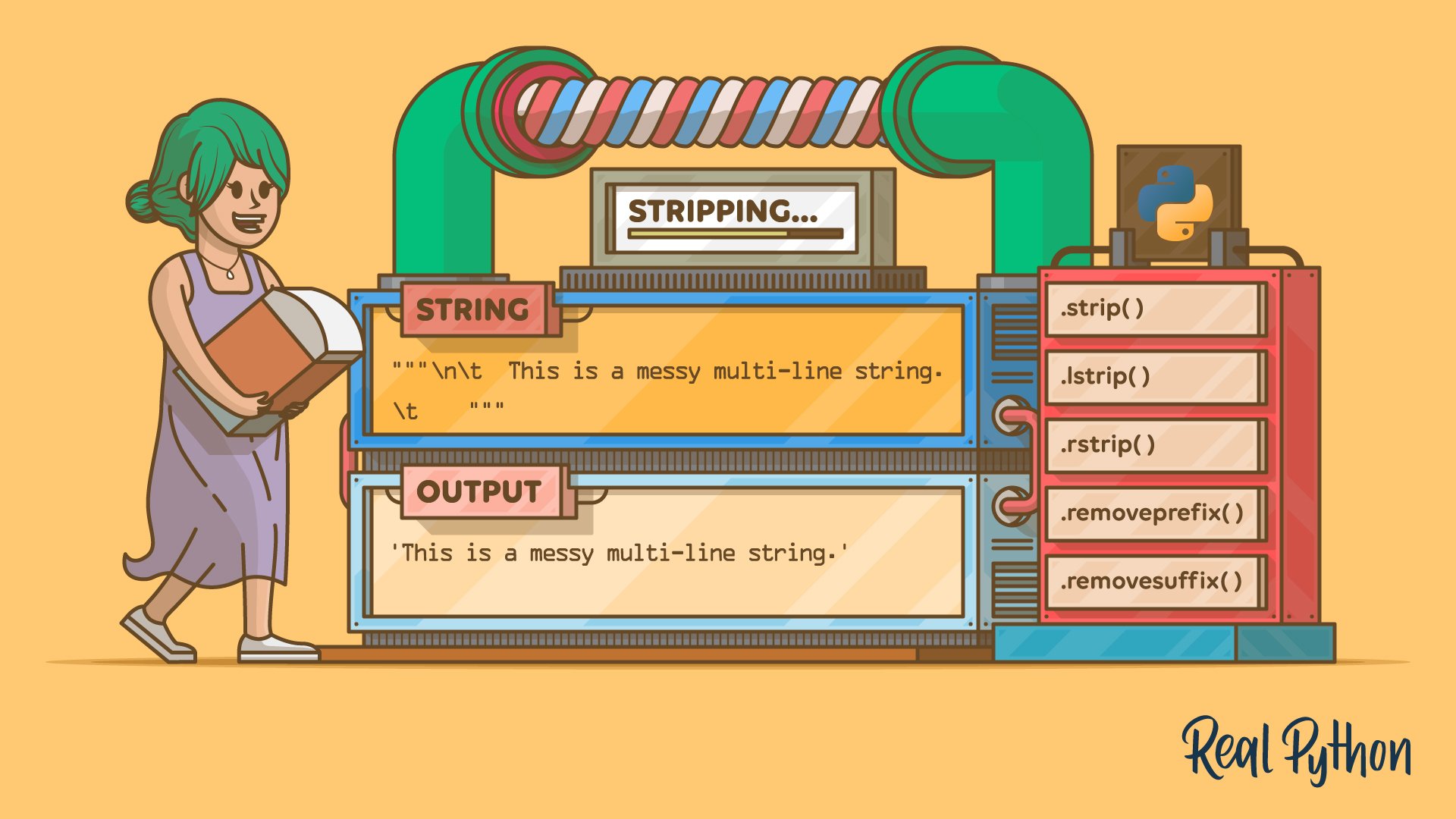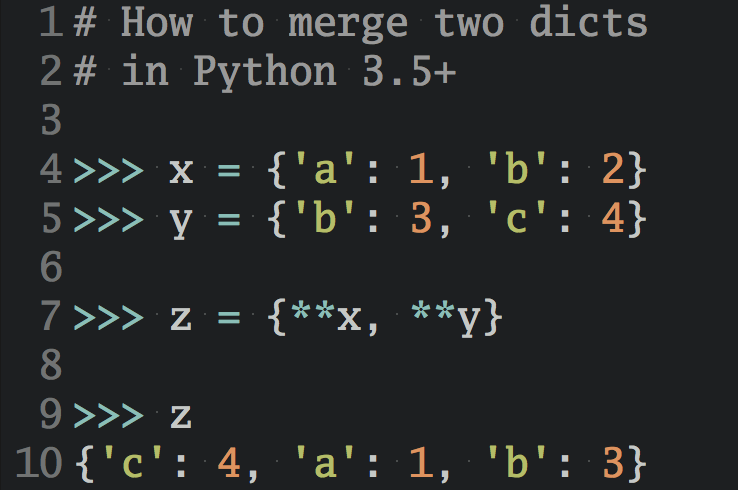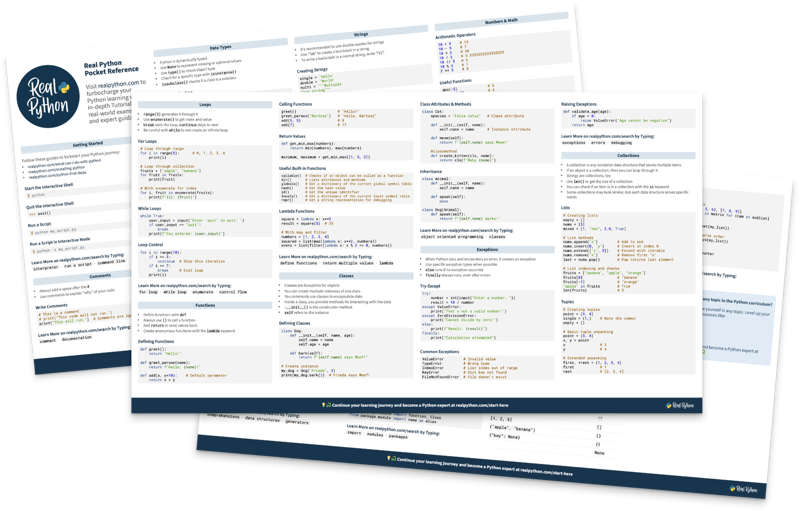Watch Now This tutorial has a related video course created by the Real Python team. Watch it together with the written tutorial to deepen your understanding: Strip Characters From a Python String
By default, Python’s .strip() method removes whitespace characters from both ends of a string. To remove different characters, you can pass a string as an argument that specifies a set of characters to remove. The .strip() method is useful for tasks like cleaning user input, standardizing filenames, and preparing data for storage.
By the end of this tutorial, you’ll understand that:
- The
.strip()method removes leading and trailing whitespace but doesn’t remove whitespace from the middle of a string. - You can use
.strip()to remove specified characters from both ends of the string by providing these characters as an argument. - With the related methods
.lstrip()and.rstrip(), you can remove characters from one side of the string only. - All three methods,
.strip(),.lstrip(), and.rstrip(), remove character sets, not sequences. - You can use
.removeprefix()and.removesuffix()to strip character sequences from the start or end of a string.
In this tutorial, you’ll explore the nuances of .strip() and other Python string methods that allow you to strip parts of a string. You’ll also learn about common pitfalls and read about practical real-world scenarios, such as cleaning datasets and standardizing user input.
To get the most out of this tutorial, you should have a basic understanding of Python strings and character data.
Get Your Code: Click here to download the free sample code that shows you how to strip characters from a Python string.
Take the Quiz: Test your knowledge with our interactive “How to Strip Characters From a Python String” quiz. You’ll receive a score upon completion to help you track your learning progress:
Interactive Quiz
How to Strip Characters From a Python StringIn this quiz, you'll test your understanding of Python's .strip(), .lstrip(), and .rstrip() methods, as well as .removeprefix() and .removesuffix(). These methods are useful for tasks like cleaning user input, standardizing filenames, and preparing data for storage.
How to Use Python’s .strip() Method to Remove Whitespace From Strings
Python’s .strip() method provides a quick and reliable way to remove unwanted spaces, tabs, and newline characters from both the beginning and end of a string. This makes it useful for tasks like:
- Validating user input, such as trimming spaces from email addresses, usernames, and other user-provided data.
- Cleaning messy text gathered through web scraping or other sources.
- Preparing data for storage to ensure uniformity before saving text to a database.
- Standardizing logs by removing unwanted spaces.
If you don’t provide any arguments to the method, then .strip() removes all leading and trailing whitespace characters, leaving any whitespace within the string untouched:
>>> original_string = " Hello, World! "
>>> original_string.strip()
'Hello, World!'
When you call .strip() on a string object, Python removes the leading and trailing spaces while keeping the spaces between words unchanged, like in "Hello," and "World!". This can be a great way to clean up text data without affecting the content itself.
However, whitespace isn’t just about spaces—it also includes common characters such as newlines (\n) and tabs (\t). These often appear when you’re dealing with multi-line strings or reading data from files. The default invocation of .strip() effectively removes them as well:
>>> text = """\n\t This is a messy multi-line string.
...
... \t """
>>> text.strip()
'This is a messy multi-line string.'
Here, .strip() removes all leading and trailing whitespace characters, including newlines and tabs, leaving only the text content. After having cleaned your strings using .strip(), they’re in better condition for displaying or further processing the text. This can be especially useful when you’re dealing with structured data, such as logs or CSV files, where you need to process many strings in a row.
At this point, you’ve learned how .strip() handles whitespace removal. But what if you need to strip specific characters, not just whitespace? In the next section, you’ll see how you can use this method to remove any unwanted characters from the start and end of a string.
Remove Specific Characters With .strip()
Sometimes, you need to remove specific characters other than whitespace. For example, when your text is delimited by unwanted symbols, or when you have to handle text that’s plagued by formatting issues. You can use .strip() to remove specific characters by passing these characters as an argument to the method:
cleaned_string = original_string.strip(chars=None)
Here, chars is a string argument that you can pass to .strip(). If you don’t pass it, then it defaults to None, which means the method will remove whitespace characters.
Instead, you can pass a string value that contains all the characters needing removal from both ends of the target string. Note that .strip() doesn’t treat the argument as a prefix or suffix, but rather as a set of individual characters to strip. In the rest of this section, you’ll explore use cases of passing specific characters to .strip() for cleaning the beginning and end of a string.
The .strip() method is useful when you want to remove punctuation marks, specific symbols, or other unwanted characters. For example, in sentiment analysis tasks, you may need to remove question marks or exclamation marks from text data:
>>> review = "!!This product is incredible!!!"
>>> review.strip("!")
'This product is incredible'
Since you pass "!" as an argument, .strip() removes all exclamation marks from both ends of the string while leaving the text content intact. Keep in mind that .strip() removes all occurrences of the specified characters at once, not just the first one it encounters.
You can also use .strip() to remove multiple specified characters from both ends of a string. For example, some of the product reviews you’re dealing with may be in Spanish and use a combination of exclamation marks and inverted exclamation marks:
>>> review = "¡¡¡Este producto es increíble!!!"
>>> review.strip("¡!")
'Este producto es increíble'
By passing both characters as an argument to .strip(), the method effectively removes all occurrences of either "¡" or "!" from the beginning and end of the string.
Another use case could be to standardize usernames before allowing them in your database, for example, removing underscores, exclamation marks, or other symbols:
>>> submitted_username = "_!__Yo_JohnDoe!__!!"
>>> cleaned_username = submitted_username.strip("!_")
>>> cleaned_username
'Yo_JohnDoe'
The .strip() method cleans both the beginning and end of the string in a single step. As you may have noticed, the order of the characters that you pass as an argument doesn’t matter. The .strip() method treats chars, the argument passed to it, as a set rather than a sequence, so the order is irrelevant.
In the example above, the submitted username contains a mix of underscores and exclamation marks at the beginning and end. Calling .strip() on it while passing "!_" as an argument removes all instances of these characters from both ends of the string.
You could have also swapped the order of the characters in the argument, passing "_!", and the result would be the same:
>>> submitted_username = "_!__Yo_JohnDoe!__!!"
>>> submitted_username.strip("_!")
'Yo_JohnDoe'
Keep in mind that Python’s .strip() method doesn’t check the order of characters in the argument or the text. It just removes any of these characters until it encounters a character that isn’t in the set. This makes .strip() a powerful tool for cleaning text data without worrying about the order of characters—but it can also be a pitfall if you assume that order matters!
Compare .strip() With Other Python Strip Methods
Python provides several string methods to remove unwanted characters from the beginning or end of a string. While .strip() removes any specified characters from both ends, .lstrip() and .rstrip() allow for targeted character removal on a single side. Additionally, .removeprefix() and .removesuffix() remove exact substrings from the beginning or end of the string, respectively.
In this section, you’ll explore the differences between these methods and when to use each one.
Use .lstrip() and .rstrip() for One-Sided Removal of Character Sets
If you need to remove characters from only one side of a string, then use .lstrip() for the beginning or .rstrip() for the end. Just like .strip(), they remove individual occurrences of a set of specified characters rather than full substrings, and stop as soon as they encounter a character that’s not in the given set. By choosing the appropriate method, you can decide whether to target the removal at the left or the right of the string:
>>> filename = "mp3audio.mp3"
>>> filename.lstrip("3pm")
'audio.mp3'
>>> filename.rstrip("3pm")
'mp3audio.'
In the example above, .lstrip() with "3pm" as an argument removes all leading "3", "p", and "m" characters until it reaches "a", resulting in 'audio.mp3'. On the other hand, .rstrip() with the same argument removes these characters from the right side of the string, stopping at "." and leaving 'mp3audio.'. There’s nothing better than listening to MP3 audio while drinking your cup of tea at 3pm!
Note: The order of the characters in the string argument to either of these methods doesn’t matter, just like with .strip(). This example used "3pm", but you could have used any permutation of these three characters to achieve the same result.
For readability, it may be sensible to order the characters alphabetically, as in "3mp", but since that’s not a time of day, sometimes logic must give way to mediocre jokes.
When you need to remove a set of characters from either the left or right side of a string, then you should use .lstrip() and .rstrip() instead of .strip(). However, keep in mind that both methods remove sets of characters, and don’t assume that they remove specific character sequences.
If you need to remove specific sequences, then you should work with .removeprefix() and .removesuffix() instead.
Remove a Prefix With .removeprefix()
Assume that you need to clean a batch of filenames because they contain prefixes that need stripping. Using .strip() or .lstrip() for this isn’t the right approach because both methods remove individual occurrences of each character in the provided argument. They don’t remove entire substrings:
>>> filename = "txt_transcript.txt"
>>> filename.strip("txt_")
'ranscript.'
In this example, using .strip() with "txt_" removes any leading or trailing occurrences of "t", "x" or "_", stripping these characters individually rather than treating "txt_" as a complete sequence. In fact, the second occurrence of "t" in the argument is superfluous and might be an indicator that the developer isn’t using .strip() correctly.
As a result, the code returns 'ranscript.', stripping off both the "txt_" prefix, an extra t, and the "txt" suffix after the period. This probably isn’t the intention of this code.
Instead, you can use .removeprefix() for a descriptive and solid way to remove a prefix from a Python string. This method removes only the exact prefix that you pass as an argument, and only from the beginning of the string. It doesn’t affect any other characters:
>>> filename = "txt_transcript.txt"
>>> filename.removeprefix("txt_")
'transcript.txt'
Here, calling .removeprefix() on filename while passing "txt_" as the argument removes the substring "txt_" from the start of the string. It leaves everything else unchanged, returning a nice and clean 'transcript.txt'.
If the prefix doesn’t match the beginning of the string, then nothing happens:
>>> filename = "txt_transcript.txt"
>>> filename.strip("audio_")
'txt_transcript.txt'
In this case, the file name is left untouched. The "audio_" prefix doesn’t match the beginning of the filename string.
Using .removeprefix() provides a more reliable way to handle structured filenames, log entries, or formatted text where you need to cleanly remove a known prefix. It prevents unintended character removal and also makes code more readable and maintainable. Python also has a companion method, .removesuffix(), that targets the end of a string.
Remove a Suffix With .removesuffix()
While .removeprefix() works at the start of the string, .removesuffix() removes a matching substring from the end of the string. This is useful for stripping file extensions, log suffixes, or versioning tokens. In the example below, you use the method to remove the .txt extension from a filename, leaving only the base name:
>>> filename = "txt_transcript.txt"
>>> filename.removesuffix(".txt")
'txt_transcript'
Continuing with the example from the previous section, the filename ends with ".txt". When you pass ".txt" as an argument to .removesuffix(), the method removes the suffix, leaving only the base name. If the suffix doesn’t match the end of the string, the function returns the original string as is:
>>> filename.removesuffix(".mp3")
'txt_transcript.txt'
Just as the descriptive method name suggests, .removesuffix() only strips substrings from the end of the string. It leaves the string alone if it can’t find the provided substring at the very end of the string.
Using .removesuffix() can lead to better code when you need to strip file extensions. However, when you’re working with file paths or file extensions in the real world, it’s best to use Python’s pathlib module instead. This module implements an object-oriented approach to file handling, and its Path class is specifically designed for dealing with file paths while ensuring cross-platform compatibility.
For example, you can use .stem to extract the filename and discard the extension:
>>> from pathlib import Path
>>> filename = "txt_transcript.txt"
>>> Path(filename).stem
'txt_transcript'
Here, you arrive at the same result as when you use .removesuffix() and pass ".txt" as the argument. The .stem attribute only references the filename without the file extension. Additionally, this approach is a lot more flexible because it allows your code to work with any file extensions, not just those ending in .txt.
Choose the Right Method for Character Removal
The .strip() method is a versatile method for removing whitespace and specific characters from both ends of a string. However, it’s not the only method available for character removal. Depending on your use case, you need to choose between .strip(), .lstrip(), .rstrip(), .removeprefix(), and .removesuffix().
With so many different methods available for stripping parts of strings, you may lose track of when to use which one. In this section, you’ll quickly revisit the best ways to use them. You can refer to the table below for a quick reference:
| Method | Example | Result |
|---|---|---|
.strip() |
"--backup-1.log--".strip("-") |
"backup-1.log" |
.lstrip() |
"--backup-1.log--".lstrip("-") |
"backup-1.log--" |
.rstrip() |
"--backup-1.log--".rstrip("-") |
"--backup-1.log" |
.removeprefix() |
"--backup-1.log--".removeprefix("-") |
"-backup-1.log--" |
.removesuffix() |
"--backup-1.log--".removesuffix("-") |
"--backup-1.log-" |
This table summarizes what each method removes from the example string "--backup-1.log--" if you pass a single dash ("-") as an argument.
You should use .strip() when you need to remove individual characters from both ends, but make sure you remember how the method works to avoid stripping additional characters unintentionally!
If you only need to clean characters from one side, then .lstrip() and .rstrip() can help you target either the left or the right side of your string. When you need to remove specific substrings at the start or end, then you should use .removeprefix() or .removesuffix(). Note that none of these methods remove the dash in the middle of your string.
Now that you understand the differences between these methods, the next section will cover the common pitfalls to avoid when using .strip().
Avoid Common Pitfalls and Edge Cases
While Python’s .strip() method may appear straightforward, using it incorrectly can lead to unintended behavior. In this section, you’ll clear up a few potential misunderstandings that may arise when working with .strip().
Approaching the topic from a perspective of what can go wrong can help to strengthen your understanding and intuition for working with .strip() and related string methods. You’ll also learn alternative solutions to address these challenges.
Assuming .strip() Removes All Whitespace From a String
A common misconception is that .strip() removes all instances of whitespace, even from the middle of a string. Instead, it only trims characters from the beginning and end:
>>> spacy_text = " Hello , World ! "
>>> spacy_text.strip()
'Hello , World !'
Here, .strip() removes only leading and trailing spaces. The whitespace between the text content remains untouched, which may not be your intention. If your goal is to normalize whitespace throughout the entire string—removing excessive spaces in between words as well—then you need a different approach.
To properly remove redundant spaces within the string, you can use the string methods .split() and .join() together:
>>> words = spacy_text.split()
>>> words
['Hello', ',', 'World', '!']
>>> " ".join(words)
'Hello , World !'
This two-step approach ensures that multiple spaces collapse into a single space while maintaining the overall sentence structure.
If your goal is to completely remove all spaces, then another method like .replace() is more appropriate:
>>> spacy_text.replace(" ", "")
'Hello,World!'
In this example, you’ve replaced all occurrences of a space character (" ") with an empty string (""), effectively removing all spaces from the text.
Assuming .strip() Removes Specific Character Sequences
Programmers often assume that .strip(chars) removes a specific sequence of characters. However, it actually removes any of the specified characters—in any order! This can give unexpected results.
For example, you may want to remove the leading "ban" from banana and incorrectly attempt to use .strip() for that purpose:
>>> fruit = "banana"
>>> fruit.strip("ban")
''
In the code block above, you can see that .strip() doesn’t treat the argument as a whole word or sequence. Passing "ban" as an argument removes all "b", "a", and "n" characters from both sides, which leads to an empty string in this case. Assuming that .strip() removes character sequences could trip you up when you’re dealing with filenames, or handling text with specific prefixes or suffixes, such as HTML tags:
>>> html_tag = "<p>premium content</p>"
>>> html_tag.strip("<p>")
'remium content</'
Here, you wanted to strip off the HTML tag <p>. However, .strip("<p>") removes all "<", "p", and ">" characters from both the start and end of the string. The function doesn’t check their order in the argument or in the text—it simply removes any of these characters until it encounters a character that isn’t in the set. This leaves you with an oddly cut text piece—not exactly a premium result for your web scraping pipeline!
If you need to remove sequences of characters, then you should use .removeprefix() and .removesuffix(). These string methods remove exact sequences rather than a set of individual characters:
>>> fruit = "banana"
>>> fruit.removeprefix("ban")
'ana'
>>> html_tag = "<p>premium content</p>"
>>> html_tag.removeprefix("<p>").removesuffix("</p>")
'premium content'
The .removeprefix() method works by scanning the beginning of a string and removes only the exact sequence of characters that you specified as the prefix. As you can see, fruit.removeprefix("ban") checks if the string "banana" starts with "ban" and removes it, resulting in "ana".
In the second example, you chained together .removeprefix() and .removesuffix(), passing them the opening and closing HTML tags, respectively. With this approach, you effectively removed both tags from the beginning and end, leaving only the premium content text for you to continue working with.
When you need to remove substrings instead of character sets, then use .removeprefix() and .removesuffix() instead of .strip(), .lstrip(), or .rstrip().
Handling Uncommon Whitespace Characters
The .strip() method only removes some whitespace characters, such as spaces, tabs, and newlines. Granted, those are the most common ones, but when your text comes from non-standard sources, then it may include other types of whitespace characters.
For example, parsing a PDF file or fetching content from the web may leave you with invisible Unicode characters in your strings. In such cases, you can’t rely on the default behavior of .strip() and you’ll need to explicitly remove these characters:
>>> text = "\u200b\u200b\u200bHello\u200b\u200b"
>>> print(text)
Hello
>>> text.strip()
'\u200b\u200b\u200bHello\u200b\u200b'
The text that you’re working with contains multiple zero width space (U+200B) Unicode characters. You can see that they’re part of the string, but if you print the string it looks to you just like any old whitespace. However, when you attempt to remove this exotic type of whitespace using the default behavior of .split(), you’ll notice that it doesn’t work.
Instead, you’ll have to explicitly remove the character by passing it as the argument:
>>> text.strip("\u200b")
'Hello'
While .strip() removes regular spaces and other common whitespace characters, it doesn’t remove all characters that get displayed as whitespace. If you need to remove characters such as U+200B, then you’ll need to do it explicitly.
Apply .strip() to Real-World Use Cases
At this point, you’ve learned how .strip() works, how it compares to similar methods, and some potential pitfalls to watch out for. In this section, you’ll explore some practical use cases—for example, you may want to use .strip() to clean datasets, format filenames, or prepare user input for further processing.
Combine .strip() With Other String Methods
In real-world applications, you may often want to combine .strip() with other string methods, such as .lower(), .replace(), or .split(), when cleaning and standardizing data. Imagine you’re processing filenames received from different sources, and they come with inconsistent formatting. The short code snippet below demonstrates how you could combine .strip() with other methods to standardize filenames:
>>> filename = " Report_2025 FINAL.pdf "
>>> filename.strip().lower().replace(" ", "_")
'report_2025_final.pdf'
In this example, .strip() removes unnecessary spaces, .lower() ensures consistency by converting text to lowercase, and .replace(" ", "_") standardizes leftover spaces within the filename as underscores.
Here, you may notice that the order of method chaining is crucial to getting the expected output. If you had called .replace() before .strip(), then unwanted spaces would interfere with the transformation:
>>> filename.lower().replace(" ", "_").strip()
'___report_2025_final.pdf__'
This time, you call .lower() and .replace(" ", "_") before .strip(). While .strip() is still waiting to get to work, .replace() already replaced all spaces—including leading and trailing ones—with underscores. Since there aren’t any leading or trailing spaces left, .strip() has no effect, resulting in the final string "___report_2025_final.pdf__".
This demonstrates why method order matters when you’re using .strip() in combination with other string methods. Certain transformations can make later steps redundant or have no effect.
Clean Data With .strip()
In large datasets, inconsistencies like extra spaces, tabs, or newline characters often appear due to human input errors, system exports, or data scraping. Customer names in a database may have unintended spaces, or product codes from different sources could contain trailing newlines.
These inconsistencies lead to mismatches in searches, faulty data merging, or incorrect analysis. For smooth operations, it’s crucial to clean your data before processing it further.
A possible approach to handling such issues is to apply .strip() to every row in a dataset to ensure uniform formatting across all records. Below is an example of how you can efficiently apply .strip() inside a list comprehension to clean up a list of names with inconsistent whitespace:
>>> data = [" Alice ", " Bob ", " Charlie\n", "\tDora"]
>>> cleaned_data = [name.strip() for name in data]
>>> cleaned_data
['Alice', 'Bob', 'Charlie', 'Dora']
In this example, .strip() removes leading and trailing whitespace from each item in data, which helps eliminate inconsistencies caused by extra spaces. In fact, a single .strip() call is enough to handle whitespace, newline, or tab characters all in one go!
However, while .strip() can be useful for basic cleanup like shown in this example, it’s usually just one step in data cleaning. Other issues, such as inconsistent formatting, missing values, or incorrect data types, may still persist.
Use .strip() in Conditional Pipelines
You use conditional pipelines in data processing when you need to check for specific conditions before proceeding. The .strip() method is especially useful when you’re handling optional user input or verifying conditions in a pipeline.
For example, you can use .strip() to check for empty user input and take the next steps based on the condition:
>>> user_input = " "
>>> if not user_input.strip():
... print("Empty input detected!")
...
Empty input detected!
Calling .strip() without arguments removes all whitespace characters, and the conditional statement checks if the input is empty. Since " ".strip() returns an empty string, this check helps filter out blank or whitespace-only inputs. Based on checking this condition, you can take further steps like displaying an error message, prompting the user to re-enter the input, or proceeding with the next stage of the pipeline.
Now that you know some effective ways to use .strip(), you can confidently apply it to various tasks, from cleaning filenames to standardizing user input. By combining it with other string methods, you ensure your data is clean, consistent, and ready for further processing.
Conclusion
In this tutorial, you’ve delved into the functionality of Python’s .strip() method and how you can use it to remove unwanted whitespace and specific characters from the beginning and end of strings. You learned how .strip() compares to related methods like .lstrip(), .rstrip(), .removeprefix(), and .removesuffix(), and how to avoid common pitfalls when using these methods.
Understanding how to effectively use .strip() and its related methods can help you when you work with text processing. These string methods are helpful tools for preparing clean and consistent string data, which is a fundamental task in data analysis, file handling, and user input validation.
In this tutorial, you’ve learned how to:
- Use
.strip()to remove leading and trailing whitespace or specified characters from strings. - Differentiate between
.strip(),.lstrip(), and.rstrip()for targeted character removal. - Remove specific character sequences with
.removeprefix()and.removesuffix(). - Avoid common pitfalls and misconceptions about the behavior of
.strip(). - Combine
.strip()with other string methods for better data cleaning and standardization.
As you continue to work with strings in Python, remember to use .strip() judiciously. By understanding its behavior and limitations, you can avoid common pitfalls and ensure your text data is clean and consistent. You’ve made it to the end of the tutorial! Check out the FAQs to strip away any leftover doubts and start using .strip() confidently in your Python projects.
Get Your Code: Click here to download the free sample code that shows you how to strip characters from a Python string.
Frequently Asked Questions
Now that you have some experience with stripping characters from Python strings, you can use the questions and answers below to check your understanding and recap what you’ve learned.
These FAQs are related to the most important concepts you’ve covered in this tutorial. Click the Show/Hide toggle beside each question to reveal the answer.
If you don’t provide an argument, then .strip() removes all leading and trailing whitespace characters, including spaces, tabs (\t), and newlines (\n).
No, .strip() only removes characters from the start and end of a string. If you need to remove characters from the middle, use .replace() instead.
Yes! You can pass any character, including punctuation and symbols, as an argument to .strip().
While .strip() removes characters from both ends, .lstrip() removes characters only from the left, and .rstrip() removes characters only from the right.
No, .strip() removes individual characters, not sequences. Use .removeprefix() and .removesuffix() to remove exact prefixes and suffixes.
Take the Quiz: Test your knowledge with our interactive “How to Strip Characters From a Python String” quiz. You’ll receive a score upon completion to help you track your learning progress:
Interactive Quiz
How to Strip Characters From a Python StringIn this quiz, you'll test your understanding of Python's .strip(), .lstrip(), and .rstrip() methods, as well as .removeprefix() and .removesuffix(). These methods are useful for tasks like cleaning user input, standardizing filenames, and preparing data for storage.
Watch Now This tutorial has a related video course created by the Real Python team. Watch it together with the written tutorial to deepen your understanding: Strip Characters From a Python String







